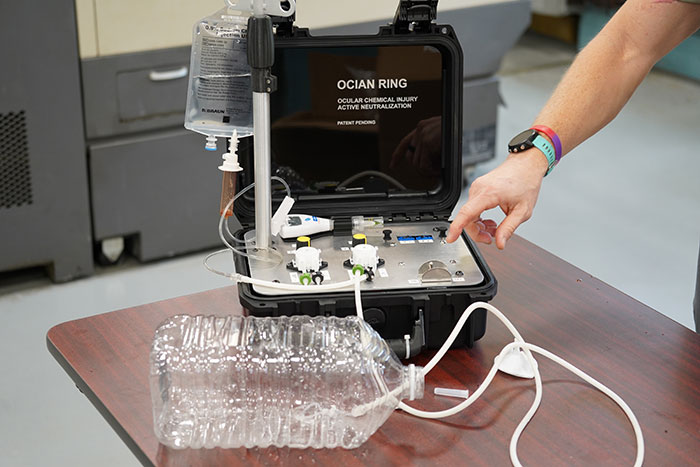MPDL Projects Past and Present
Patient Movement Items Support Device (PMISD)
The PMISD was designed to attach to a North Atlantic Treaty Organization (NATO) compliant litter and provide a structure to securely mount required medical patient movement items. The frame of the PMISD has been designed utilizing a common medical mounting rail as its frame thereby providing maximum configuration versatility. This enables medical personnel to use individual medical devices on various medical platforms thus saving lives on the battlefield.
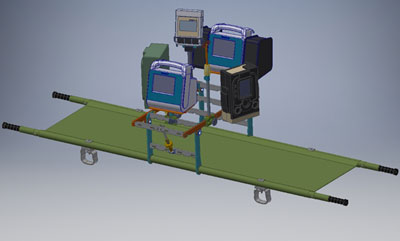
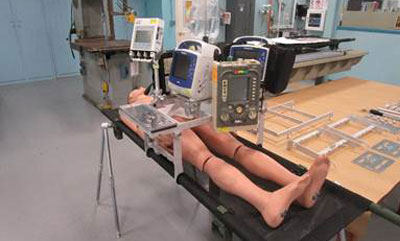
A Warfighter Health, Protection, and Evacuation (now Soldier Medical Devices) Project Management Office Team, comprised of Mark Brown, Jay Bartlett, Mark Easterday and Scott Walters from the MPDL and our Product Manager, Mr. Jaime Lee, received a patent for the PMISD. The Patient Movement Item Support Device was designed, developed, and prototyped for an Air Force reimbursable project. Due to the unique functional design, interchangeability of medical devices/accessories and interest within the MRDC we applied for and received a patent for the PMISD. Additionally, the technology was transferred to Morzine Medical to produce along with their other related patient movement products.
COVID-19 Airway Management Isolation Chamber (CAMIC)
CAMIC is an adjunct personal protective equipment (PPE) barrier device constructed by placing a large clear plastic bag on a PVC piping box frame over the head, neck and shoulders of patients. The CAMIC provides laminar airflow circulation inside the chamber allowing for rapid removal of aerosolized particles. When used with other PPE, CAMIC protects health care personnel by providing a physical barrier to aerosolized droplets from patients with COVID-19 by capturing and removing viral particles emitted by the patient. The invention, patent application, Emergency Use Authorization, and commercial licensing of this technology was involved contributions from both clinical partners/inventors at Walter Reed National Military Medical Center, Madigan Army Medical Center, and other DoD Medical Centers, and engineers/co-inventors and support staff from the US Army Medical Research and Development Command. The MPDL designed numerous variants of varying materials (not all shown) for testing and user feedback.
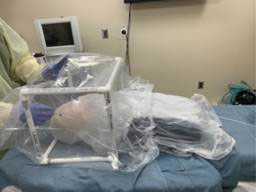
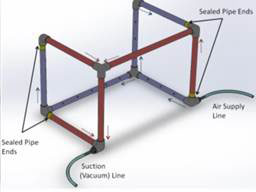
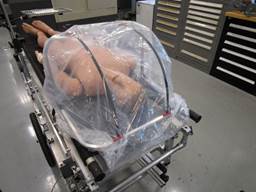
Ocular Chemical Injury Active Neutralization (OCIAN) Ring
Project for Brooke Army Medical Center via Medical Research and Development Command Medical Technology Transfer Office. Allows for simultaneous corneal and deep forniceal irrigation for emergency eye treatment of chemical eye burns, thermal burns, irritants, foreign bodies on the surface, cleansing prior to eye or eyelid surgery, or infection. This technology can be inserted on the sight of injury by EMS providers, offering quicker response time and effective irrigation.
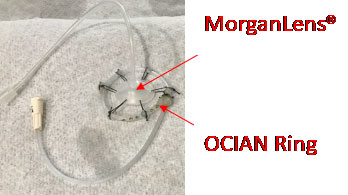
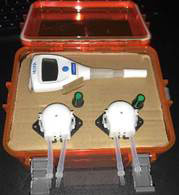
Joint Light Tactical Vehicle (JLTV) Ambulance Kit
Produced for the Warfighter Health, Protection, and Evacuation (now Soldier Medical Devices) Project Management Office. Casualty Evacuation (CASEVAC) using non-medical transportation platforms requires CASEVAC kits to adapt the platform and enable movement of the wounded from the battlefield to the next levels of medical care. Currently the JLTV program is in production without an ambulance variant. In future conflicts, units wil use the JLTV for CASEVAC of patients. Because of this, linking the CASEVAC kit to the JLTV is critical to ensure and maintain battlefield medical readiness. A kit consists of the hardware to load and safely hold a patient facing upwards into a vehicle of opprtunitiy, a "scoop & run" capability. A JLTV prototype kit was developed by the MPDL for safe medical evacuation of casualties using the existing JLTV utility vehicle. The kit has the same mobility and survivability as the other JLTV variants.
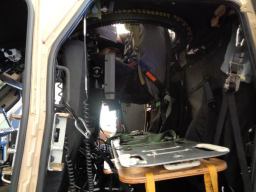
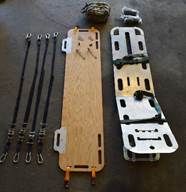
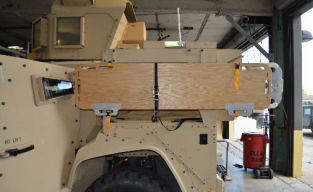
HEATPAC
Produced in support of the Arctic and Extreme Cold Weather Operations efforts of the Warfighter Health, Protection, and Evacuation (now Soldier Medical Devices) Project Management Office. The Heatpac heater was developed as a self-contained heat source for use in cold temperatures particularly for keeping casualties warm. It permits infusions to be carried out at sub-zero temperatures and can also be used for frost protection of medical supplies. It can be used inside a sleeping bag or as a heater for sensitive electronic equipment etc. The original Heatpac was discontinued over a decade ago and the MPDL was enlisted to recreate and update the technical data package, materials and manufacturing methods to modern methods.
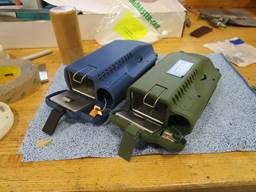
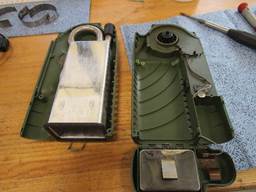
SIRKIN-HILES RAIL (SHRAIL)
Produced through an Interagency Agreement with the USAMRDC Office of Research and Technology Applications. Providing care to litter based patients is cumbersome and less than ideal, but often necessary. Operating Room (OR) tables offer a massive potential that is currently not possible with litters. The SHRAIL brings this potential to all litters, making litters safe, effective surgical platforms. The SHRAIL comes in six or fewer simple pieces. The rail has standard "OR" dimensions. Designed to fit within multiple vehicles and the "English table." Provides attachment points for more than just OR tools.
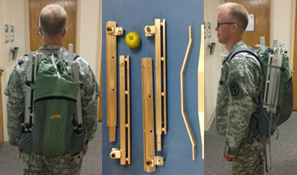
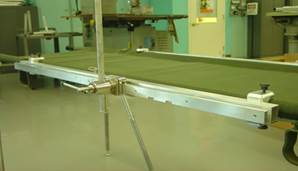
Trimano Camera Holder
Project for Uniformed Services University of the Health Sciences via Medical Research and Development Command Medical Technology Transfer Office. Connection device for adjustable instrument support arm (Arthrex Trimano Fortis Support Arm) and various recording devices during surgery. The device also includes a sterile plastic sleeve that can be slid over the camera/cellphone/tablet, allowing the surgeon to interact with the device and remain sterile during the surgery. Additional work included an adaptation for the Smith & Nephew Spider2 Limb Positioner. Both versions attach to COTS cellphone, tablet, GoPro™ mounts as well as any device that connects to a traditional tripod.
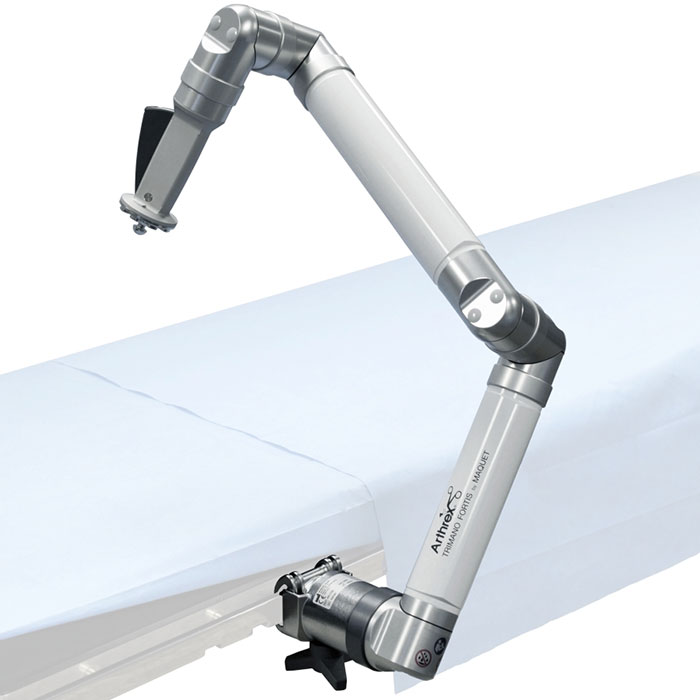
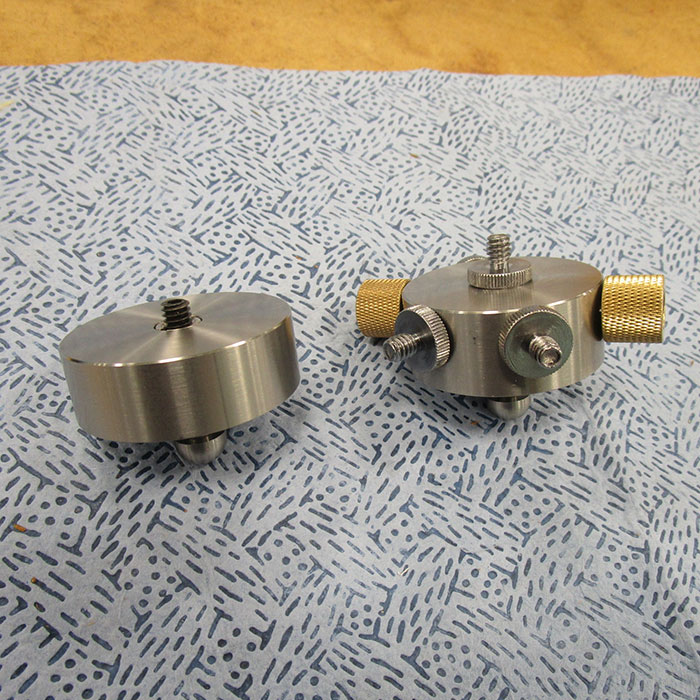
Dural Cutter
Produced through an Interagency Agreement with the USAMRDC Office of Research and Technology Applications. This invention relates to a surgical device for use in brain surgery, and methods to open the dura matter during brain surgery. The cutting assembly comprises a dural elevator, a dural retainer which extends over the dural elevator, and a blade housed vertically between the dural elevator and dural retainer. The 'delta hook' cutter resembles a small 'seatbelt cutter'. The MPDL fabricated several versions with removable and non-removable handles as well as a blade version that attaches to any typical scalpel handle.
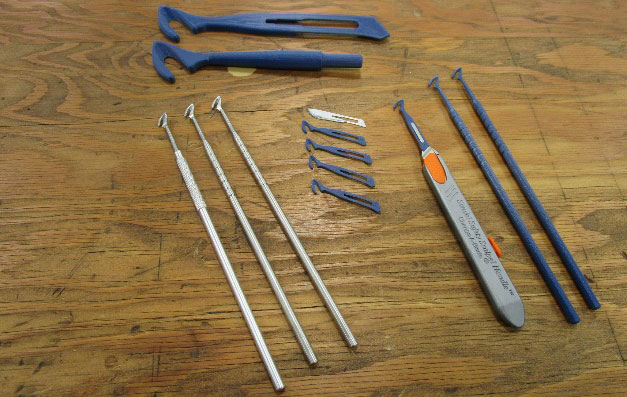
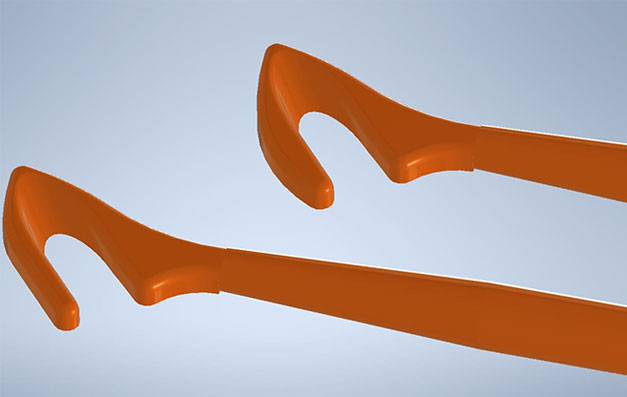
Readily Improvised IntraOsseous Trainer (RIOT)
Produced through an Interagency Agreement with the USAMRDC Office of Research and Technology Applications. A Simple Training Device for Maintenance of Tibial Intraosseous Placement Technique in the Austere Environment. The Readily Improvised intraOsseous (IO) Trainer (RIOT) device was developed while deployed using materials available at a Role I facility to provide a training model for tibial IO placement. Appropriate placement of an intraosseous device is a perishable skill and requires retraining and familiarization to maintain proficiency. The MPDL is assisting the inventor in creating a reproduceable, reusable, and marketable system for training applications, including simulated bone markers utilized for proper insertion location.
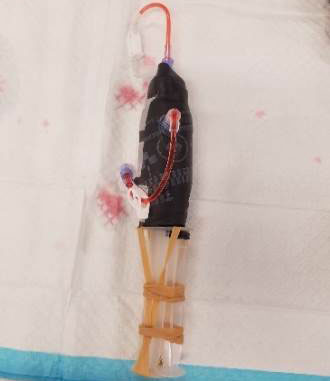

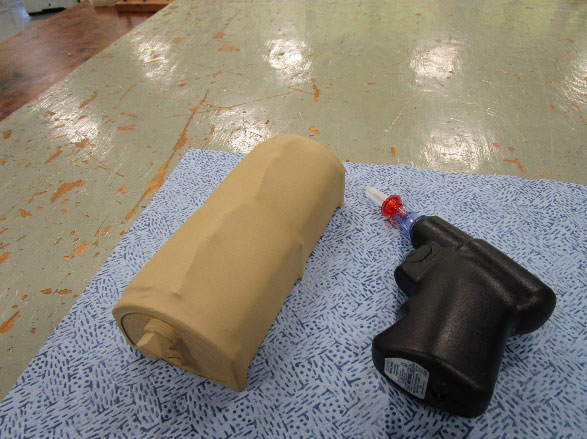
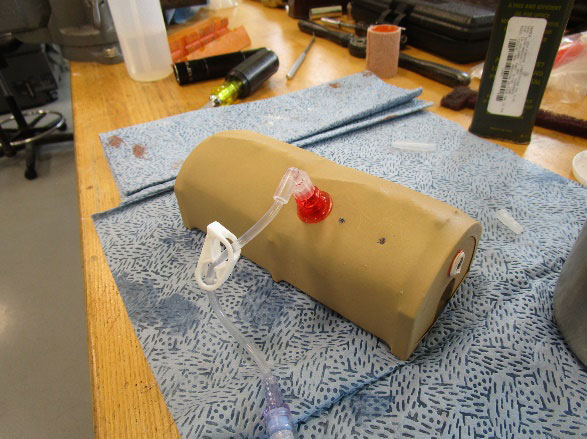
Harper Innovative Safety Suture Kit
Produced through an Interagency Agreement with the USAMRDC Office of Research and Technology Applications. The Harper Innovative Safety Suture Kit combines the realistic feel of surgery with educational teaching of science, technology, engineering and mathematics (STEM) and the childhood fun of "Operation" all in one kit. This simulation kit significantly reduces the potential for sharp injury by eliminating the scalpel and suture scissors and replacing these tools with a blunted needle and safety shears similar to those used in pre-k and kindergarten classrooms. The blunted needle eliminates the possibility of accidental sticks. Premade holes have predetermined cannulated paths, reinforcing the utilization of proper surgical technique when rotating the "needle" and needle driver through the tissue. This supports development of the fine motor skills and manual dexterity needed in surgical subspecialties like Otolaryngology. The prefabricated design embedded in the multilayer tissue design enhances the durability of the tissue and reusability of the kit.














